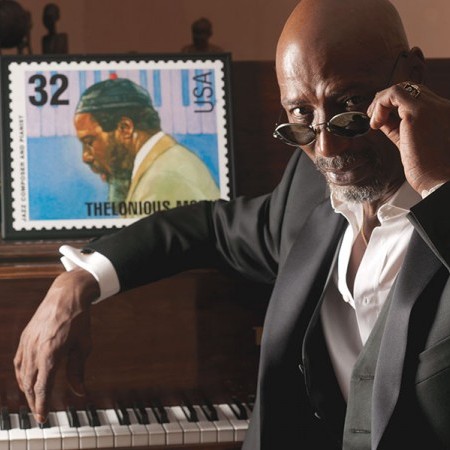
T.S. Monk at home
(Photo: Michael Weintrob)For jazz musicians, the first line of communication is to the other musicians with you on the bandstand. And there’s a respect that goes along with that. If everybody played it right and you know you played it wrong, don’t act like you didn’t play it wrong. Sound everybody [out], and say, “You know, I jammed that up. And thank you, you gave me that ‘one’ that got me back. And thank you for not freaking out because I know the changes were jammed up.”
THELONIOUS USED TO TEACH lessons like that all the time. He taught Ben Riley a lesson in lateness once. This was before I was playing with the band. They were playing in Cleveland. I’ll never forget because it was a gangster joint called Leo’s Casino. And when we got in the joint, I swear everybody in the joint looked like they were straight out of The Godfather.
Across the street from Leo’s Casino was a strip joint, right? The two young guys in the band were Larry Gales and Ben Riley. So, naturally, in between sets these guys are saying, “Hey, let’s go see what the girls are doing.” So they started going over to see what the girls were doing. They were going over every night … . But I could see, because I was going to the club every night, that they were cutting it closer and closer and closer to set time. And this one night, Larry Gales came running back, but Ben ain’t there. And Thelonious was of a mind [T.S. looks at his watch]: “Hit it.” So, they hit without Ben Riley. This is going to sound unbelievable, but I swear I’m not lying. About 10 minutes into the set, Ben Riley comes running into the club … running into the club. He done jammed up. He runs up onto the bandstand and gets into the groove. So, I’m sitting there saying, “OK, everything’s groovy now. Everything’s cool.” So, Rouse takes a solo, Thelonious takes a solo and Larry Gales takes a solo. And Ben goes to take his solo.
When Ben takes his solo, Thelonious gets up off the piano. He looks at Rouse and says, “Come here.” He looks at Larry Gales and says, “Come here.” They go walking down off the bandstand, and he looks at me and says, “C’mon.” I follow him. We go out of the club. We get in a taxi. We go back to the hotel. We go up to the room. Thelonious had a room with a record player. He puts on Art Tatum. So, me, Thelonious, Charlie Rouse and Larry Gales are back at the hotel listening to Art Tatum records.
Nobody’s saying a word. Larry and Rouse ain’t saying nothing to Thelonious. I don’t know what’s going on, so I’m not saying anything. I’m just following everybody. I swear we must have stayed there for 15 or 20 minutes. All of a sudden, Thelonious says, “OK, let’s go back.”
We go downstairs. We have to wait for the guy to get us a cab. We get a cab. We go back to the club. I can tell you that when we got back to the club, Ben Riley was a shell of his former self. He had been up on that bandstand for about 45 minutes soloing. Needless to say, Ben Riley was never late again. [laughs]
WHAT HAPPENED TO JAZZ EDUCATION in the first 40 years was that it was discovered. It was realized that this music, which came from these untrained, sometimes uneducated African Americans, was one of the most highly intellectual endeavors ever tried on the planet Earth. And when white music educators discovered that, they tried to hijack the music without the artisans. So, for instance, by the mid-’60s, schools were creating curricula on bebop. Now, in the 1960s, Thelonious Monk was alive. Dizzy Gillespie was alive. Max Roach was alive. Hank Jones was alive. Roy Haynes was alive. All those founders of bebop were alive. Did any of them get a call from a curriculum development person? No, they didn’t.
THE THELONIOUS MONK INSTITUTE OF JAZZ was formed in 1986. Basically, the idea was to recreate the interface that I had grown up with. I knew the best way to teach jazz was to put young musicians with the masters. That’s how I learned. That’s how my daddy learned. That’s how John Coltrane learned. That’s how Miles learned. That’s how everybody learned. So, this is very different than how you teach European classical music.
Jazz is a very hands-on music. It’s passed down personally. It comes out of the African tradition—the oral tradition. So, you pass it down that way. And that is what gave rise to the Thelonious Monk Institute of Jazz. In the past 25 years, we have tried to interact with anybody who is anybody in jazz. And, more importantly, we’ve tried to interact with everybody who has been profoundly influenced by jazz.
EVERY PROGRAM for the past 25 years, every single program that the Monk Institute has done, has been 100 percent free for our students. No kid has had to pay a nickel to interact with Herbie Hancock; not a dime to interact with Ron Carter or Wayne Shorter or Jimmy Heath or Clark Terry or any of the people who have been involved.
THIS IS THE MOST wonderful music. This is the most human music of all time. It will never go anywhere unless human beings stop desiring to be individuals. And that’s not going to happen. So, we are healthier now, despite marketplaces and all that stuff. As an art form, we are healthier now than we have ever been. DB





